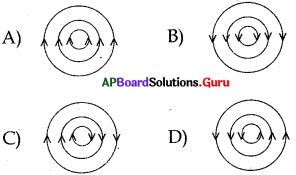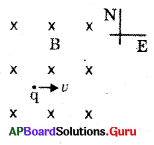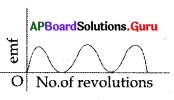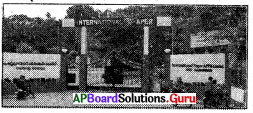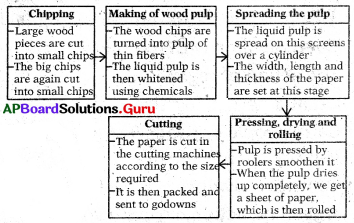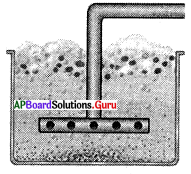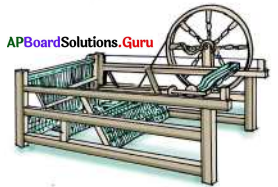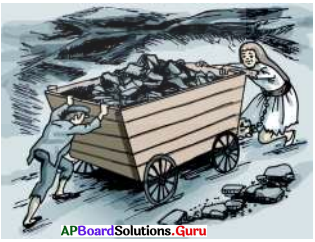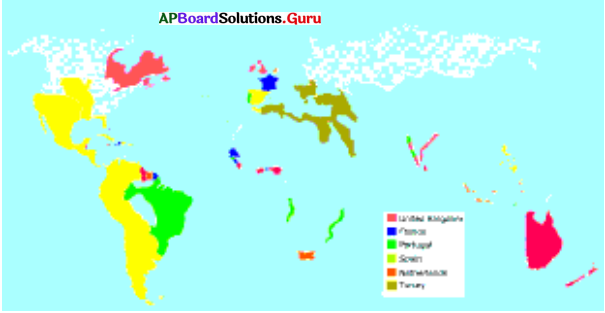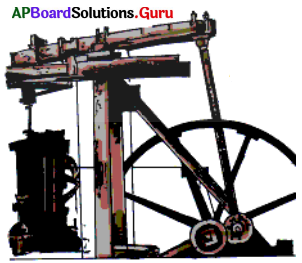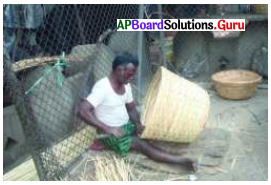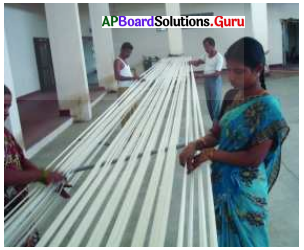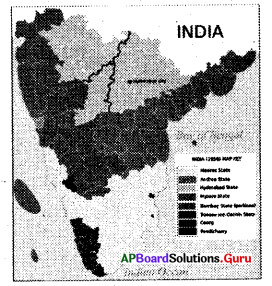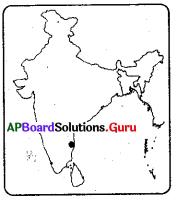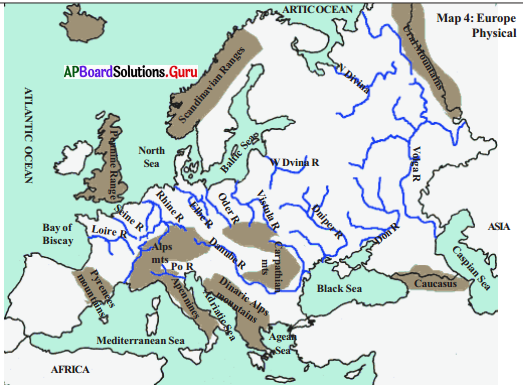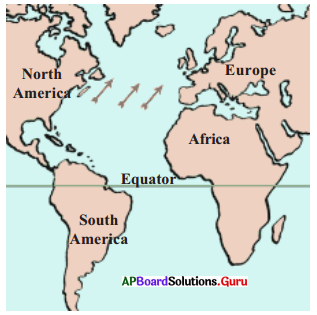Practice the AP 7th Class Social Bits with Answers Chapter 10 Importance of Transport System on a regular basis so that you can attempt exams with utmost confidence.
AP State Syllabus 7th Class Social Bits 10th Lesson Importance of Transport System with Answers
Choose the correct answer.
Question 1.
Highways built across different ……….. in the country.
A) States
B) Towns
C) Villages
D) Tribal areas
Answer:
A) States
Question 2.
………….. are responsible for village roads.
A) Mandal Parishats
B) Panchayats
C) Z.Ps
D) State government
Answer:
B) Panchayats
![]()
Question 3.
………… share of travelers in India use trains.
A) 2/5
B) 3/5
C) 1/5
D) 2/7
Answer:
C) 1/5
Question 4.
There are …………. airports in A.P.
A) 2
B) 3
C) 5
D) 6
Answer:
D) 6
Question 5.
……….. are major trading centers.
A) Port cities
B) Villages
C) Historical cities
D) Capitals
Answer:
A) Port cities
Question 6.
……….. are mostly transported by ships.
A) People
B) Goods
C) Animals
D) Plantations
Answer:
B) Goods
![]()
Question 7.
Motorcycles and ………. are used in a big way.
A) cycles
B) lorries
C) cars
D) trucks
Answer:
C) cars
Question 8.
Coal is transported through ………… transport.
A) Road
B) Rail
C) Both A & B
D) Air
Answer:
C) Both A & B
Question 9.
………… are more crucial in foreign trade.
A) Airports
B) Main cities
C) Seaports
D) State capitals
Answer:
C) Seaports
![]()
Question 10.
………… is a domestic airport.
A) Puttaparthi
B) Dum Dum
C) Santha Cruz
D) Rajiv Gandhi
Answer:
A) Puttaparthi
Question 11.
The paper industry uses ………….. to bring their raw material.
A) Trucks
B) Vans
C) Lorries
D) Trains
Answer:
C) Lorries
Question 12.
The ………….. maintain accounts, repair buses or work in bus depots.
A) Politicians
B) Farmers
C) Lawyers
D) Employees
Answer:
D) Employees
Question 13.
Construction and maintenance of roads are mostly under this ownership in India.
A) Public
B) Private individuals
C) Public, Private individuals
D) Foreigners Collaboration
Answer:
A) Public
Question 14.
These are connected cities in different states in our country
A) State Highways
B) National Highways
C) Village Roads
D) Z.P. road
Answer:
B) National Highways
![]()
Question 15.
The NH-7 runs through these states
A) U.P, M.P.
B) Maharashtra, Telangana
C) A.P, Karnataka, Tamilnadu
D) All the above
Answer:
D) All the above
Question 16.
This government maintains the roads which connect small towns with districts
A) central government
B) state government
C) Z.P.s
D) local governments
Answer:
B) state government
Question 17.
…………. are responsible for the roads made of gravel and urban roads.
A) Gram Panchayats, Corporations, Municipalities
B) Central government, state governments
C) Central, state, and local governments
D) None
Answer:
A) Gram Panchayats, Corporations, Municipalities
Question 18.
There are ………… ports in Andhra Pradesh.
A) 20
B) 15
C) 18
D) 16
Answer:
B) 15
![]()
Question 19.
The railways are mainly used for transport these
A) coal, raw iron
B) fertilizers, cement
C) food grains
D) all the above
Answer:
D) all the above
Question 20.
This state has no coastal line or shipyards
A) Maharashtra
B) Andhra Pradesh
C) Telangana
D) Gujarat
Answer:
C) Telangana
Question 21.
The biggest shipyard out of 15 shipyards in Andhra Pradesh.
A) Kakinada
B) Visakhapatnam
C) Nijampatnam
D) Kalingapatnam
Answer:
B) Visakhapatnam
Question 22.
International trade happens through these
A) roadways
B) railways
C) waterways
D) airways
Answer:
C) waterways
![]()
Question 23.
The ways used by more in Andhra Pradesh.
A) roadways
B) railways
C) waterways
D) airways
Answer:
A) roadways
Question 24.
This share of villages has transport facilities in 2001 in Andhra Pradesh.
A) 1/2nd
B) 2/3rd
C) 3/4th
D) 4/5th
Answer:
C) 3/4th
Question 25.
The farmers should carry their produce to this place
A) Rythu Bazar
B) Market
C) Resort
D) Park
Answer:
A) Rythu Bazar
Question 26.
The no. of buses in APSRTC run by 1,20,000 employees
A) 8,000
B) 9,000
C) 20,000
D) 11,000
Answer:
C) 20,000
![]()
Question 27.
The share of two-wheelers on Andhra Pradesh roads out of one crore vehicles.
A) 1/2nd
B) 2/3 rd.
C) 3/4 th
D) 4/5th
Answer:
C) 3/4 th
Question 28.
The transport system is dependent on these
A) Availability of transport facilities
B) Transport charges
C) Both A & B
D) Gravity
Answer:
C) Both A & B
Question 29.
The important means of transport to far off countries, either for human beings or for goods, from centuries together
A) Aeroplanes
B) Trains
C) Buses
D) Ships
Answer:
D) Ships
Question 30.
The people cannot move from one place to another place at this time.
A) when transport cost is more
B) when transport cost is less
C) when the people receive high incomes
D) none
Answer:
A) when transport cost is more
![]()
Question 31.
The persons who occupy pavements for business
A) Pedestrians
B) Vendors
C) Vehicle drivers
D) Common people
Answer:
B) Vendors
Question 32.
The no. of people living in, six big cities in India increased by two times during 1981 to 2001 whereas the no. of motor vehicles went up by ………….. times during the same period.
A) 7
B) 6
C) 5
D) 8
Answer:
D) 8
Question 33.
The issues which show more effect on the families of low income
A) road accidents
B) deaths
C) wounds
D) all the above
Answer:
D) all the above
Question 34.
In the first week of every year, the Road Transport departments all over the country celebrate
A) Library week
B) Rail week
C) Road Safety Week
D) None
Answer:
C) Road Safety Week
![]()
Question 35.
Whatever may be the means of transport one should follow
A) Traffic rules
B) Fundamental duties
C) Directive principles
D) None
Answer:
A) Traffic rules
Question 36.

What does the picture show?
A) Airport
B) Seaport
C) Island
D) Peninsula
Answer:
B) Seaport
Question 37.
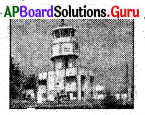
What does the picture show?
A) Airport
B) Seaport
C) Factory
D) Lighthouse
Answer:
A) Airport
![]()
Question 38.
One has to prefer public transport system because
A) Over pollution due to carrying more people
B) They move long distances
C) Cost is more
D) They carry more people so that using individual vehicles reduce leading to less pollution
Answer:
D) They carry more people so that using individual vehicles reduce leading to less pollution
Question 39.
Following traffic rules help
A) To avoid accidents
B) To avoid pollution
C) To carry less luggage
D) To carry more luggage
Answer:
A) To avoid accidents
Question 40.
Find the correct statement.
1. Horse cart is a manual.
2. Bus is mechanical and manual.
A) 1 only
B) 2 only
C) Both 1 & 2
D) None
Answer:
C) Both 1 & 2
![]()
Question 41.
Match the following:
A B
1. APSRTC [ ] A) Road Transport
2. National Highways [ ] B) BRDB
3. State Highways [ ] C) Central Government
4. Border roads [ ] D) State Government
A) 1 – A, 2 – B, 3 – C, 4 – D
B) 1 – B, 2 – C, 3 – D, 4 – A
C) 1 – A, 2 – C, 3 – D, 4 – B
D) 1 – C, 2 – D, 3 – B, 4 – A
Answer:
C) 1 – A, 2 – C, 3 – D, 4 – B
Question 42.
Find the correct statement.
1. Road Transport provides door-to-door delivery.
2. Railways constructions are very cheap.
A) 1 only
B) 2 only
C) Both 1 & 2
D) None
Answer:
A) 1 only
Question 43.
If you want to travel fastly from Vijayawada to Delhi, you opted
A) Bus
B) Train
C) Aeroplane
D) Car
Answer:
C) Aeroplane
![]()
Question 44.
Most of the accidents are occurring in
A) Roadways
B) Railways
C) Airways
D) Waterways
Answer:
A) Roadways
Question 45.
Vehicles are registered at
A) Collectorate Office
B) R.T.O. Office
C) Village Office
D) Transport Minister Office
Answer:
B) R.T.O. Office
Question 46.
Which of the following we should follow when we are riding on a motorcycle?
A) Overtaking the vehicles
B) Drunk and drive the vehicles
C) Wearing a helmet
D) To run the vehicles on footpath
Answer:
C) Wearing a helmet
![]()
Question 47.
Road safety week
A) First week of January
B) Last week of January
C) the First week of December
D) Last week of December
Answer:
A) First week of January
